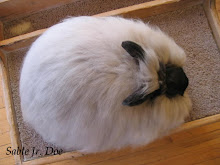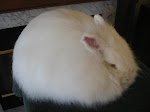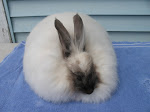--This is a post from the old blog, but it seemed relevant to re-post in the middle of the Spring/Summer breeding season.
Someone at a show recently asked that I write a post about breeding, so here it is, LOL.
Some people have a great deal of trouble getting their angoras bred, and others have very few issues at all. I believe that there are several factors involved in a successful breeding program, and different lines and breeds may exhibit different rates of conception as well.
First of all, it is very easy to encourage and increase problem breeders in your herd. What I mean by this, is that angora breeders generally focus on breed traits such as wool yield and coat quality to the extent that the more basic fundamentals of rabbit raising often get overlooked, and a herd can become less "functional" over time. As I have often said before, the strength of a breed such as the French Angora is that it is a true multi-purpose livestock animal. It produces heavy wool yields on a commercial quality meat body, and is pound for pound one of the most efficient livestock animals that exists. It is important, with a breed such as this, not to neglect it's meat value at the expense of wool only. The FA is primarily a Fiber animal, but when we fail to select for strong breeders in our herds we make it impossible for the meat aspects of the breed to perpetuate themselves, and the wool qualities fail at the same time.
If you have reluctant breeders in your herd----or rabbits who almost never conceive/fail to get milk, etc.----do NOT keep these rabbits or any of their offspring in your herd if you are serious about improving your production. A heavily line/inbred herd will normally have a decreased reproductive rate to begin with due to homozygosity, so it is a good idea to occasionally introduce an outside doe if you find the vigor of your herd declining. If your herd is NOT heavily linebred then basic culling is the only answer----do not keep those rabbits who are poor mothers or poor milkers, and eventually the production of your herd will improve. Selection for these types of traits is not always something that Angora people think of, but we need to remember that rabbits are rabbits, so if we fail to pay attention to the basics of herd management we will have nothing to show or harvest to begin with:(.
Conception can become a problem if a doe is allowed to sit dormant for an extended period of time between breedings. In my own barn I try not to let 'older does' (the 2-3 years and older) go for more than 2 months between litters after weaning. What I try to do is keep only those bunnies who are capable of being championed early so that they can have their first 3 legs by the time they are 9 months--1 year old. At this point I clip them down and breed them immediately to get the first litter out of the way, and then if the doe happens to be one who can bounce back with good wool growth and type again after the litter, I bring them back to the show table again, and then shear and breed them again. If a doe is retired from showing OR it is a doe who was never shown to begin with (a "parts rabbit", so to speak), then those rabbits will be bred all year round with one month off between litters until approx. 3-4 years old, when they are retired completely due to their age.
The does who are the most heavily bred have the best conception rates of all. They almost never miss breedings and almost always have good sized litters who grow up healthy and robust. It is important to note that the longer an adult doe goes unbred, the greater the opportunity exists for fat to build up around the internal organs to inhibit reproduction and make it less likely that the doe will ever conceive. A good rule of thumb is to get your bunnies championed early if possible (if you show), and then don't be afraid to breed heavily afterward and continue a tight schedule until their retirement. A rabbit in good health is essentially a breeding machine (as any good meat producer will tell you), so it is important to encourage good production by maintaining a regular breeding schedule.
Other things to remember when preparing to breed are to breed at appropriate times of the year. Rabbits breed all year round if kept on a tight schedule, but the ideal seasons are Spring and Fall (particularly Spring). In Spring even the hay we feed contains a higher amount of a compound called 6-MBOA (6-methoxybenzoxazolinone) which stimulates reproductive readiness in wild animals and enhances libido. The length of the days are also directly related to receptivity, and the sperm counts of younger bucks are quicker to bounce back after the heat of summer into Fall as well.
Here is a list of other tips to encourage the breeding process:
1--clip bucks and does down before breeding so that the coat is out of the way and the doe's wool will only be approx. 1 in. long when it comes time to kindle (making it less likely to wrap around baby necks and feet).
2--Breed once first thing in the morning, and then again one hour later.
3--Cage reluctant does next to smelly bucks at least 2 hours before breeding to increase receptivity.
4--take the doe for a ride in the car along bumpy side roads.
5--make positively certain that your herd is well-nourished with a good quality pellet that contains adequate supplies of Vitamins A and E. Supplement brood does with lots of green, leafy plants and herbs which contain a great deal of Vitamin A such as Comfrey before breeding and during gestation.
6--If you feel that your does are overweight, place them on a restrictive diet for 3-4 weeks before breeding to enhance conception rates. In sophisticated meat operations, rabbitry owners are careful never to let their breeding does get too fat----they want them lean and mean, not overweight and lazy:).
7--Try to keep bucks as cool as possible in hot weather. Whenever the temperature goes above 80 degrees F for any length of time, the fertility of bucks will almost always decrease. Younger bucks recover their sperm counts fairly quickly, but older ones can remain sterile for up to 4 months.
Restrained breeding is a technique that some breeders use when a doe seems reluctant, but the conception rates for this method is lower than if you simply let the doe and buck breed naturally. Try to let nature take it's course whenever possible.
To summarize (here at the end now), here are the best ways to encourage good production in your herd:
----Select away from bad mothers, reluctant breeders, and bad milkers, and breed only the offspring of those does who have an excellent track record in the production department.
----Keep your herd does in production, working show dates around your litters, and then keep them constantly bred afterward until they are old enough to retire.
----Clip coats down before breeding and expose the doe to the buck ahead of time (in separate cages).
----Maintain a healthy herd with no vitamin or mineral deficiencies.
One more thing I forgot to mention comes back to what I have often said about the importance of maintaining a predictable schedule in your rabbitry. If your rabbits are managed in the same way every day with no surprises or changes in routine, they will have much lower stress levels which contribute to increased readiness for breeding. A well-cared for herd is much more likely to perform better in EVERY area, including showing, conditioning, and most definitely breeding.
Sunday, June 21, 2009
Subscribe to:
Post Comments (Atom)























No comments:
Post a Comment